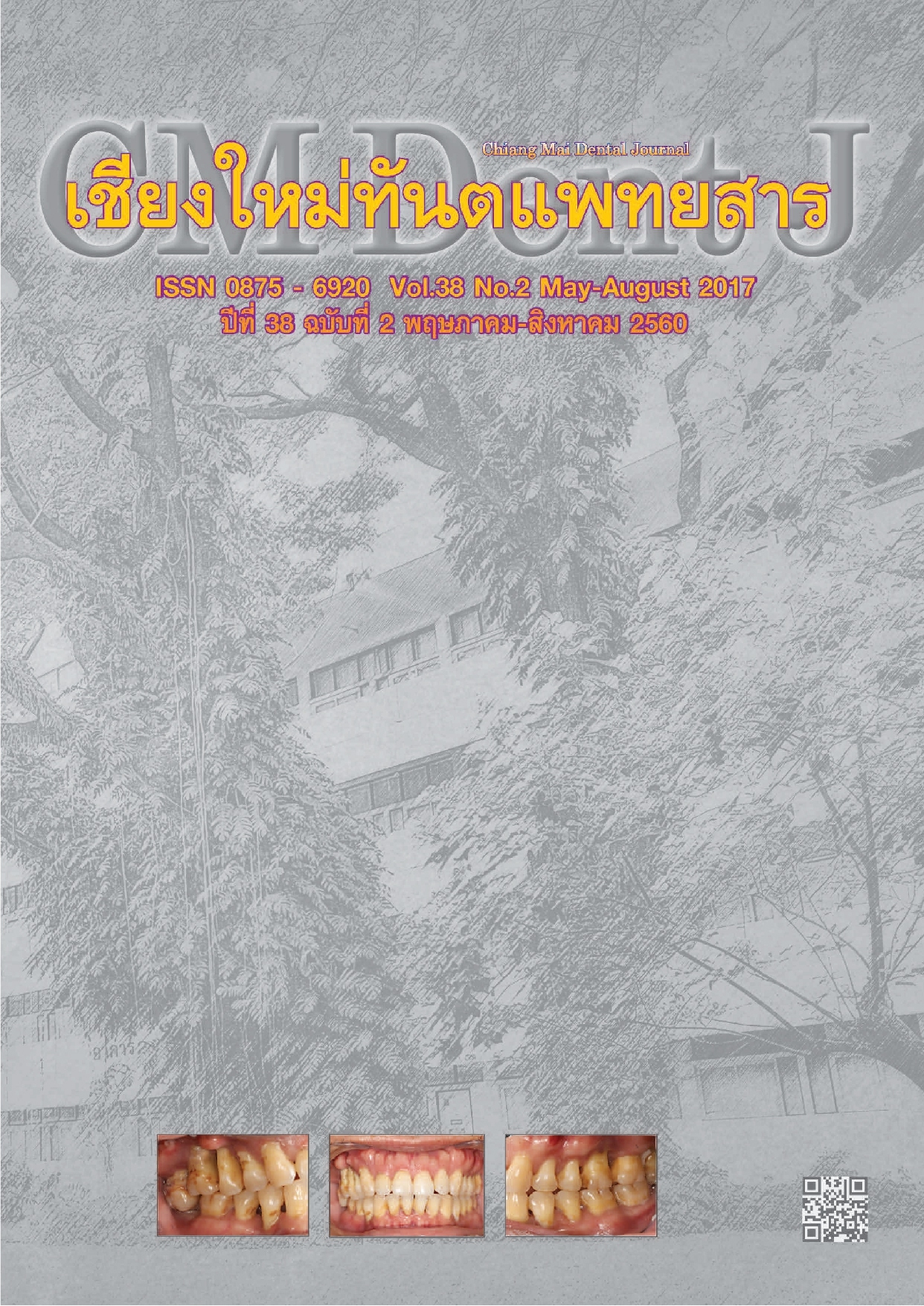Effect of Dental Gloves Contamination to Resin-dentin Bond Strength
Main Article Content
Abstract
Objective: The aim of this study was to evaluate the effect of powdered and powder-free latex gloves contamination on dentin bond strength of 2 step self-etch adhesive system.
Material and Method: Forty flat superficial dentin from human third molars were prepared and finished with 600-grit silicon carbide abrasive paper. The teeth were divided into 5 groups as follows: group 1-as a control, group 2 or 3-composite resin surfaces were contaminated by powdered latex dental gloves without or with wiping with 70% alcohol respectively, group 4 or 5 composite resin surfaces were contaminated by powder-free latex dental gloves without or with wiping with 70% alcohol respectively. Composite resins were filled-up on dentin surface bonded with a 2-step self-etch adhesive (ClearfilTM SE Bond), and then stored in 37°C water for 24 hours. After that the teeth were sectioned into beam-shape specimens at resin-dentin bond interface of 1x1 mm2 and subjected to microtensile bond strength test. Data were analyzed with one-way ANOVA and Tukey test (p<0.05). Failure mode was determined by using a stereomicroscope and SEM, and analyzed with Chi-square test (p<0.05).
Result: There were significant differences between control group (65.08 MPa) and 4 contaminated groups. The bond strengths of contaminated groups were significantly decreased in group 5 (58.01 MPa), group 3 (53.98 MPa), group 2 (52.64 MPa) and group 4 (49.41 MPa) (p<0.05), respectively.
Conclusion: Contamination from dental gloves decreased the bond strength between composite resin and dentin. Thus, operators should avoid touching or shaping composite resin by dental gloves even their surfaces were wiped with 70% alcohol.
Article Details
References
Kohn WG, Collins AS, Cleveland JL, Harte JA, Eklund KJ, Malvitz DM. Guidelines for infection control in dental health-care settings. MMWR recommendations and reports 2003; 52(17): 1-61.
Yip E, Cacioli P. The manufacture of gloves from natural rubber latex. J Allergy and Clin Immunol 2002; 110(2 Suppl): S3-14.
Van Meerbeek B, Yoshihara K, Yoshida Y, Mine A, De Munck J, Van Landuyt KL. State of the art of self-etch adhesives. Dent Mater 2011; 27(1): 17-28.
Hilton TJ, Ferracane JL, Broome J. Fundamentals of operative dentistry: a contemporary approach. 4th edition. Quintessence book, 2013.
Yazici AR, Baseren M, Dayangac B. The effect of current-generation bonding systems on microleakage of resin composite restorations. Quintessence Int 2002; 33(10): 763-769.
Arı H, Donmez N, Belli S. Effect of artificial saliva contamination on bond strength to pulp chamber dentin. Eur J Dent 2008; 2(2): 86-90.
de Carvalho Mendonça EC, Vieira SN, Kawaguchi FA, Powers J, Matos AB. Influence of blood contamination on bond strength of a self-etching system. Eur J Dent 2010; 4(3): 280-286.
Chang SW, Cho BH, Lim RY, Kyung SH, Park DS, Oh TS, Yoo HM. Effects of blood contamination on microtensile bond strength to dentin of three self-etch adhesives. Oper Dent 2010; 35(3): 330-336.
Cacciafesta V, Sfondrini MF, De Angelis M, Scribante A, Klersy C. Effect of water and saliva contamination on shear bond strength of brackets bonded with conventional, hydrophilic, and self-etching primers. Am J Orthod Dentofacial Orthop 2003; 123(6): 633-640.
Xie J, Powers JM, McGuckin RS. In vitro bond strength of two adhesives to enamel and dentin under normal and contaminated conditions. Dent Mater 1993; 9(5): 295-299.
Sfondrini MF, Fraticelli D, Di Corato S, Scribante A, Gandini P. Effect of water contamination on the shear bond strength of self-ligating brackets. Oral Sci Int 2013; 10(2): 49-52.
Martins NM, Schmitt GU, Oliveira HL, Madruga MM, Moraes RR, Cenci MS. Contamination of composite resin by glove powder and saliva contaminants: Impact on mechanical properties and incremental layer debonding. Oper Dent 2015; 40(4): 396-402.
Belvedere P, Turner WE. Direct fiber-reinforced composite bridges. Dent Today 2002; 21(6): 88-94.
Roberts HW, Bartoloni J. Effect of latex glove contamination on bond strength. J Adhes Dent 2002; 4(3): 205-210.
Ravikumar CM, Sangur R. Effect of five brands of latex gloves on the setting time of polyvinyl siloxane putty impression materials. Indian J Dent Res 2012; 23(2): 209-212.
Wilson DF, Garach V. Surgical glove starch granuloma. Oral Surg Oral Med Oral Pathol 1981; 51(4): 342-345.
Hubar JS, Etzel KR. Effects of glove powder on radiographic quality. J Can Dent Assoc 1991; 57: 790-792.
Oskoee SS, Navimipour Ej, Bahari M, Ajami AA, Oskoee PA, Abbasi NM. Effect of composite resin contamination with powdered and unpowdered latex gloves on its shear bond strength to bovine dentin. Oper Dent 2012; 37(5): 492-500.
Holtan JR, Lua MJ, Belvedere PC, Lambert DL. Evaluating the effect of glove coating on the shear bond strength of porcelain laminate veneers. J Am Dent Assoc 1995; 126(5): 611-616.
Ho CC, Khew M. Surface characterisation of chlorinated unvulcanised natural rubber latex films. Int J Adhes Adhes 1999; 19(5): 387-398.
Zhong JP, Li SD, Wei YC, Peng Z, Yu HP. Study on preparation of chlorinated natural rubber from latex and its thermal stability. J Appl Polym Sci 1999; 73(14): 2863-2867.
Prasansuttiporn T, Nakajima M, Kunawarote S, Foxton RM, Tagami J. Effect of reducing agents on bond strength to NaOCl-treated dentin. Dent Mater 2011; 27(3): 229-234.
Heymann HO, Swift EJ Jr, Ritter AV. Sturdevant's art & science of operative dentistry. 6th edition. Elsevier Mosby, 2013.
Stevens RV, Chapman KT, Weller HN. Convenient and inexpensive procedure for oxidation of secondary alcohols to ketones. J Org Chem 1980; 45(10): 2030-2032.
Short RD, Dorn S, Kuttler S. The crystallization of sodium hypochlorite on gutta-percha cones after the rapid-sterilization technique: an SEM study. J Endod 2003; 29(10): 670-673.


